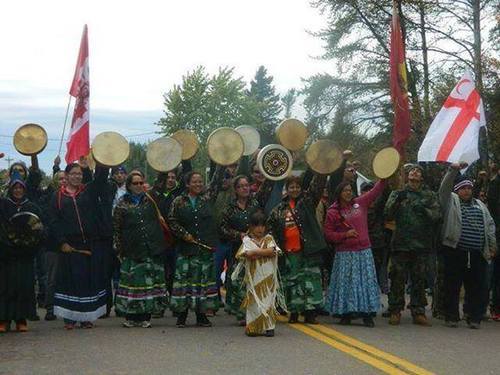 Photo of a group of Indigenous women holding flags and drums
Photo of a group of Indigenous women holding flags and drums
A Look Back on 2013: 12 Important Moments in Indian Country
By Taylor Payer
2013 was quite the year for folks in Indian Country. I’d like to take this opportunity to explore 12 important moments of this past year in Indian Country including mind-blowing events of collective action, cultural shifts and political mile-stones from Native communities.
1) Violence Against Women Act (VAWA) Passes
VAWA passes on February 12. The newly revised act includes provisions that allow tribal courts to prosecute non-Indians who commit violence against women and families on Indian lands. It also includes provisions for LGBTQ and immigrant communities. Obama signed it into law on March 7, a very important moment in Indian Country.
2) Native Sisters and Basketball Stars Play in the NCAA Final Four
Native sisters and basketball stars Shoni and Jude Schimmel play in the NCAA Women’s Basketball finals. Despite losing in the final game to University of Connecticut, the sisters led their team and inspired many young players across Indian Country.
3) Star Wars is Remade in Navajo
Star Wars: Episode IV is remade in a 40th language since its original debut, Navajo. The film, dubbed “Navajo Star Wars”, is filmed on Navajo lands and features a largely Navajo cast. This is an important moment in Indian Country due to its relevance to the ongoing projects of language revitalization. Preserving languages and culture important to many Native peoples and is often regarded as the basis of life.
4) The Baby Veronica Case Comes to a Close
On July 17, 2013, the South Carolina State Supreme Court rules in favor of the finalization of the adoption of Veronica Brown by Matt and Melanie Capobianco. Cherokee Nation is devastated after the contest long fought over custody of “baby Veronica” results in her Cherokee father, Dusten Brown, losing his daughter. The case was one of great importance to Indian Country as it bares tremendous implications for future court hearings over tribal and non-tribal rights to child custody.
5) Native Films Debut, Provide Positive and Accurate Portrayals of Native Characters
Indian Country has become accustomed to the onslaught of stereotypical and often racist media created not in their likeness but at their expense. We need look no further than the recent film made on Tonto to see how Indianness is commodified and marketed towards non-Native bodies, whose ideas of Natives come out of inaccurate textbooks and media that continues to lump all Indians into one despite tribal differences.
This year, Indian Country was treated to several films quite unlike Tonto and its predecessors. 2013 gave us award-winning films featuring Native actors, directors, and positive portrayals of Native American communities today. One of these is Tiger Eyes, which stars Tatanka Means, the son of actor and AIM activist Russell Means, who passed away last year. For more, check out ICTMN’s list of Native films in 2013.
6) Ponka-We Victors, Native State Representative, Delivers Critical Commentary on Immigration
Ponka-We Victors, the first Native American woman to serve on the Kansas State Legislature, attracts major media attention after delivering a comment on immigration at a committee hearing. In response to Kansas Secretary of State Kris Kobach, Victors said, “I think it’s funny, Mr. Kobach, Because when you mention illegal immigrant, I think of all of you.”
Victors is currently serving in the Kansas State House of Representatives and is a member of the Tohono O’odham Nation and the Southern Ponca Nation. She delivered this commentary during a hearing aimed against granting in-state tuition to college students who are undocumented. This important moment was heavily documented by media outlets across the country as people were greeted with a fact long-held by Indian peoples: if you are not Native to the lands in the US nation-state, you too are a visitor, an immigrant, some might say.
Victors’ comments on immigration also bear tremendous importance for the ongoing Indigenous campaigns for land reclamation and resource protection. The issue of immigration is not only important to the well-being of undocumented people, but also in its implications for the way we think of land. The US government’s treatment of this issue reveals its priorities and attitude toward Indigenous lands and nations, which is the premise to a rich body of Indignenous resistance movements around land.
For more on campaigns for Land and Resources, check out Nations Rising.
7) Tribal Nations Exercise Sovereignty Through Gay Marriage
On October 31, 2013, the unthinkable happened. Two gay men were married, legally, in the red state of Oklahoma, where gay marriage is by most accounts not allowed. How did this happen? Through the Cheyenne and Arapaho tribes, who have long supported same-sex relationships due to their long histories of queerness and Indigenous ideas of gender, sexuality, and ways of life. Darren Black Bear and Jason Pickel became the third same-sex couple to be married in the Arapaho tribe and the first for the Cheyenne. These tribes join the handful of others that have also married queer folks, including the first, the Coquille Tribe in Oregon and then the Suquamish in Washington.
The moment is an important one in Indian Country, because visible support of LGBT Natives is helpful to the ongoing movement for queer justice. In celebrating the love between Darren and Jason we celebrate not only queerness, but also sovereignty for Native nations and peoples. With Oklahoma being just one of thirty-five states to not allow gay marriage and the two largest Native nations, the Cherokee and Navajo also outlawing same-sex union, it is important for us Native peoples to continue asserting our sovereignty and embracing our long histories of queer living, loving, and surviving.
For more on all things queer and Indigenous: Check out the critical anthology of Queer Indigenous Studies, edited by two-spirit folks like Qwo-Li Driskell.
8) The Mascot Fight Continues
Hundreds of Natives and their allies rally outside the Metrodome on November 7 to protest against the Washington Redskins mascot. The anti-racist rally held before the Minnesota Vikings game against the Washington team was led by American Indian Movement leader Clyde Bellecourt. Among its participants was Olympic gold medalist and Native activist Billy Mills.
Throughout the year, many prominent Native and non-Native forces came out in support of the anti-mascot campaign. Among the Native supporters who spoke out against the mascot name are the Oneida Indian Nation, who have helped lead the charge against the name, basketball player Shoni Schimmel, DJ NDN from the Native hip-hop group A Tribe Called Red, and thousands more across Indian Country from many different tribal affiliations.
The non-Native supporters include the Washington DC City Council, which voted unanimously to change the team name for the second time this year, and even President Obama who told The Associated Press he would “think about changing” the Washington Redskins’ name if he were the team owner. Dan Snyder, the real owner of the team, has vowed to never change the name, and according to an AP poll, almost four of every five Americans agree with him. The survey found that only 11 percent of Americans think the name should be changed.
For more on the use of Indian mascots, visit Native Appropriations, a blog authored by Cherokee scholar Adrienne Keene.
9) Government Shuts Down, Natives Suffer
The government shut down on October 6, 2013. The effects of the shutdown were not entirely noticeable throughout the United States, but were quite obvious in Indian Country. The shutdown cut off federal funding for services many Native communities rely on as a part of the government’s treaty obligations. These include nutrition programs, foster care systems, and financial assistance for the needy. According to Aljazeera America (where you can read more), thousands of employees were furloughed by the shutdown, and the Bureau of Indian Affairs reported as many as 2,500 employees were to not report to work due to the shut down.
10) Mi’kmaq People Protest Shale Gas Exploration in New Brunswick
One of the most important examples of Indigenous grassroots resisting in 2013, was when thousands of supporters joined the Mi’kmaq in their protests against the big oil company that aimed to develop fracking projects on Mi’kmaq land. The Mi’kmaq peoples have their homelands in the Canadian province of New Brunswick and have led a fierce organizing campaign to stop the Texas-based company from exploiting their lands for oil profits. The protests come at a very particular and important time in Indian Country where land-based resistance is fueled by the momentum from the recent Idle No More movement. The media coverage of the Mi’kmaq protests have led its viewers to believe the Native peoples have been violent in their resistance, yet the protests continue in New Brunswick, and activists and elders vow that they are dedicated to non-violent action only. For further reading check out Warrior Publications.
11) Angel Haze, Cherokee Hip Hop Artist, Identifies as Two Spirit
Angel Haze has taken the music scene by storm this year. In 2013, she produced covers of many popular songs including Macklemore’s “Same Love”, maintained a strong presence on Twitter, and leaked her own album in an attempt to share art with her fans and resist the musical industrial complex. Why is Angel important to Indian Country? Well, not only does this fierce rapper identify as Cherokee and taught herself how to speak her language, she also identifies as two spirit. On November 12, she told Huffington Post that “she has always considered her self to be two-spirited.” Not only is Indian Country happy to welcome the phenomenal artist to our team, but this moment also does incredible things for queer Natives and visibility!
12) President Obama Promises to Visit Indian Country in 2014
President Obama met with a dozen tribal leaders at the 2013 White House Tribal Nations Conference this year. At the gathering he discussed job creation and the economic state in Indian Country, and promised to visit Indian Country in 2014. Obama’s promise is an important moment for Indian Country seeing as he has not yet visited a tribal nation in his campaigns, nor his presidential stints. In fact, almost no politicians of this caliber have stepped foot in Indian Country. Obama visiting Indian Country could mean an increased political consciousness on Indian peoples and issues, as well as a more nuanced understanding on the relationship between federal and tribal governments.
You can keep up with Taylor, a member of Turtle Mountain Anishinaabe, on Twitter @TaylorPayer!
Taylor Payer
Anishinaabekwe, Student, and Ryan Gosling's Boyfriend.
Catch up with me @taylorpayer.

